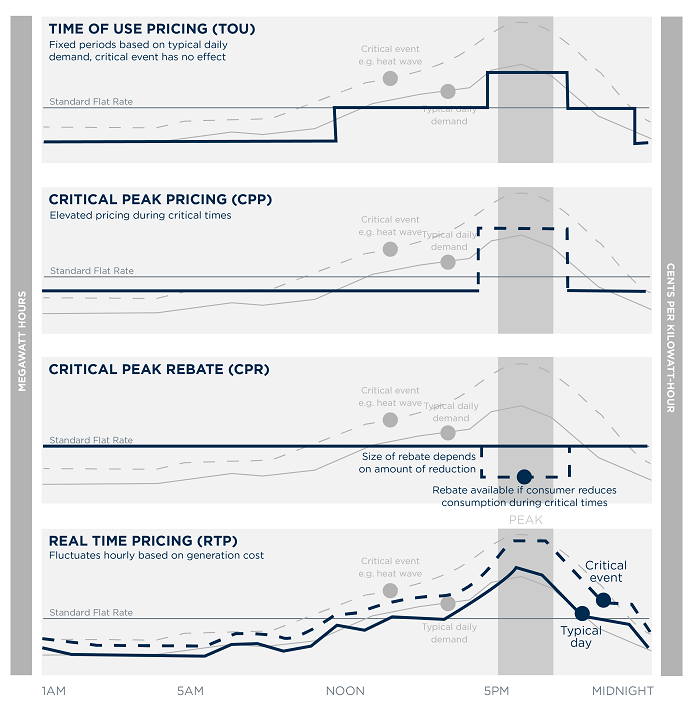
April 25, 2019 | InBrief
Time varying rates: How utilities can mitigate grid challenges while keeping rates affordable
Time varying rates: How utilities can mitigate grid challenges while keeping rates affordable
The price that you pay for electricity may be very different from what your neighbor may pay, or the small shop down the street, the farmer upstate, or the large Industrial plant miles away. Utility rates have many components, including the type of customer you are (residential, commercial agriculture, etc.), amount of energy used, income level, location, and many other factors. However, the time of day that a customer uses energy has not, until recent years, been charged differently on a customer’s bill, even though the cost to produce and deliver electricity varies significantly throughout the day.
Varying Cost to Produce Electricity
Traditional residential utility rates charge customers a set amount per kilowatt hour based on the seasonal average cost of providing electricity. The major factor determining a residential customer’s bill is how much energy the customer used. The cost to supply electricity actually varies by each minute of the day. Throughout the course of a single day, the wholesale price of electricity (or the price that utilities pay to purchase electricity) reflects that actual real-time cost for supplying electricity.
One major factor that contributes to the real time cost is demand for electricity. During work and school hours, when most of the population is away from home, the residential demand for energy is low. However, during morning and early evening hours, residential demand for energy rises rapidly as customers return home and turn on electronic devices, lighting, and cook dinner. This time period is referred to as “peak” demand.
Assistance from Renewables
Utilities face many challenges to meet peak demand in today’s electricity and gas markets. Over the last 20 years, solar, and wind resources have grown exponentially. According to the U.S. Energy Information Administration, solar and wind combined supply 8% of all U.S. electricity, at least 10% of all electricity in 18 states in the U.S., and over 20% in 9 states. Renewables are intermittent and not available when demand for electricity is highest (summer, late afternoon/early evening) causing rapid spikes. Utilities must then either build or procure excessive capacity to meet rapid spikes in demand.
On average, we use less than half of the available generation capacity, resulting in higher than necessary electricity charges to support the utility investment in the excess capacity. Additionally, the types of resources able to ramp quickly are expensive and present challenges for grid operators to balance load. Providing customers with price signals can reduce large spikes in electricity demand at times such as hot summer days.
Changing the Rate Structure
One potential solution for utilities to address the challenges faced by meeting peak demand is offering customers time varying rates. Time varying rates provide customers price incentives to reduce electricity and gas use at the highest demand times. By pricing electricity closer to the actual cost of producing it, all consumers, from large C&I users to the average residential user, are incentivized to reduce their electricity use during the highest demand periods, reducing the need to build excess capacity and thus lowering costs and electricity prices for all users.
These rates come in a few different forms that range in complexity, from the simplest Time of Use (TOU) rates, to more complex programs such as Critical Peak Pricing (CPP) and Peak Time Rebates, to the most complex and arguably most difficult to implement Real Time Pricing (RTP).
TOU rates generally offer two different prices for peak and non-peak energy use. Energy is generally cheapest overnight and on weekends and holidays when overall demand on the electricity system is relatively low. Critical Peak Pricing has a lower fixed rate most days, with certain days designated as “event” days (usually called 24-48 hours in advance) where much higher rates are charged. The reverse, Peak Time Rebates, have a normal fixed rate, but offer rebates for reducing use during the event days. Usually utilities call 12-20 “event” days, generally on the hottest summer days, to reduce demand on the days during the year where electricity demand is highest. Real Time Pricing is the most complex time varying rate structure, with hourly prices determined by day-ahead market prices or real-time spot market prices for electricity.
Time varying rates are in the early stages of adoption for residential customers in much of the U.S. and even the world, but a handful of countries and states are encouraging more widespread adoption through regulatory policy initiatives.
In this series, we will explore the current state of adoption of time varying rates, supporting technology, and policy requirements, challenges and best practices for customer education, and the outlook of time varying rates.


